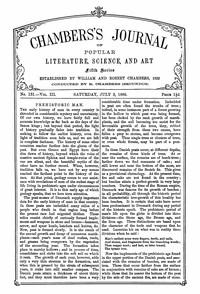Read this ebook for free! No credit card needed, absolutely nothing to pay.
Words: 20236 in 5 pages
This is an ebook sharing website. You can read the uploaded ebooks for free here. No credit cards needed, nothing to pay. If you want to own a digital copy of the ebook, or want to read offline with your favorite ebook-reader, then you can choose to buy and download the ebook.


: Chambers's journal of popular literature science and art fifth series no. 131 vol. III July 3 1886 by Various -
Release date: October 8, 2023
Original publication: Edinburgh: William and Robert Chambers, 1853
PREHISTORIC MAN.
The early history of man in every country is shrouded in considerable mystery and uncertainty. Of our own history, we have fairly full and accurate knowledge as far back as the days of the Saxon kings; but beyond that period, the light of history gradually fades into tradition. In seeking to follow the earlier history, even the light of tradition soon fails us, and we are left in complete darkness. The history of some other countries reaches further into the gloom of the past. But even Greece and Egypt have their dim dawn of history, beyond which the voice of massive ancient Sphinx and temple-ruins of the one are silent, and the beautiful myths of the other have no further record. When, however, tradition fails us, we have not by any means reached the farthest point in the history of the race. At that point, geology comes to our assistance with revelations of men of the rudest stage of life living in prehistoric ages under circumstances of great interest. It is to this early age of which geology speaks, that we here turn attention.
The peat-mosses of Denmark supply important data for the early history of man in that country. In these peats are imbedded many relics of a people who dwelt in that region long before the present race had migrated thither. These relics consist chiefly of curiously formed implements and weapons in stone and bronze--hammer, arrow, and spear heads, hatchets and knives, &c. Now, peat is formed slowly. It is the result of the annual growth and decay of numerous marsh-plants--each year's mass of dead rushes, reeds, and grasses being overgrown by the vegetation of the succeeding year. The formation takes place in marshy hollows; and in process of time, consolidates and sinks into the soft soil on which it rests. The growth of each year, however, adds only a very thin stratum to the formation, and when this is pressed by the strata of subsequent years, it sinks into still smaller compass. The Danish peats attain a thickness of about thirty feet, and they must therefore have been a very considerable time under formation. Imbedded in peat are often found the trunks of trees; indeed, in some instances part of a forest growing in the hollow in which peat was being formed, has been choked by the rank growth of marsh-plants, and the soil becoming too moist for the favourable growth of the trees, they, robbed of their strength from these two causes, have fallen a prey to storms, and become overgrown with peat. Thus single trees or clusters of trees, or even whole forests, may be part of a peat-moss.
In these Danish peats occur, at different depths, the remains of three kinds of trees. At or near the surface, the remains are of beech-trees; farther down we find remnants of oaks; and still lower and near the bottom of the moss, are discovered remains of the Scotch fir. This gives us a provisional chronology. At the present time, firs and oaks are not found in the country; but beeches attain a perfect growth in very large numbers. During the time of the Roman empire, Denmark was famous for its growth of beeches; in all probability, all through the historic period the characteristic tree-growth of this locality has been beeches. It is certain that oaks have never been predominant in Denmark during any period of the historic epoch. The prehistoric period of man's life upon the globe is divided into three divisions--the Stone age, the Bronze age, and the Iron age. These distinctions are based upon the character of the tools and weapons that he used. Lucretius hit on what was in reality these divisions when he said:
Man's earliest arms were fingers, teeth, and nails, And stones, and fragments from the branching woods; Then copper next; and last, as later traced, The tyrant iron.
As time moved on, and the events in the public and private life of that antique colony came and went, a change gradually came over the land and people. The Scotch firs, from some cause or other, passed away, and in their place grew stalwart oaks. The people developed in many ways, so that they were now able to carry on rude mining operations, and, by alloying tin with copper, produce bronze, of which henceforth they made their implements. All the relics associated in the peats with oaks are of bronze. It is interesting to remember that the 'more modern' ancients procured their tin chiefly from the mines of Cornwall, and it may have been that the people of this Bronze age found their way in their rude canoes to the coasts of Cornwall, or, at anyrate, obtained their tin from other tribes who had done business with the earliest of the Cornish miners.
In process of time, another change occurred. The conditions favourable to the growth of the oak ceased to exist, and in place of the defunct emblems of strength and durability, came a growth of fine beech-trees, which has continued, as we have seen, to beautify the country down to the present time. The people, too, improved in their knowledge of the arts, and were now able to manufacture their various articles out of the more refractory iron.
In peats of the Bronze age, scarcely any human bones have been discovered, though they occur in peats of the Iron and Stone ages, and the other relics of man are about equal in all the three epochs. Scientists seem to agree in referring this to the probability that the people of this epoch always burned their dead. It is certain that cremation is a very ancient custom, and this theory, it is to be presumed, accounts for us not finding human remains in the deposits of this period.
This period has been named by French geologists the Reindeer age, because the remains of that animal occur in very great profusion in these French caves. As a proof of the existence of man at a time when the reindeer and several other animals, now confined to far higher latitudes, roamed as far towards the equator as the south of France, perhaps farther, it is to be noticed that not only are his implements found side by side with the remains of the reindeer in such a manner as to show that they were deposited at the same time, but many of the antlers of that animal are cut and rudely carved, bearing ample evidence of the work of a more or less intelligent race of men. On one of the bones found in a cave of the Reindeer age, the outlines of the great mammoth have been rudely carved by some ingenious hand, long since laid to rest; and the long curved tusks and shaggy coat of wool are easily recognisable. M. Laret thinks that this places beyond all doubt that the early inhabitants of these caves must have seen, at least, a few specimens of this species of elephant roaming through these regions. The presence of the mammoth, one of the mammals of the Tertiary epoch, long ages ago quite extinct, known to have been clothed with a warm coat of shaggy hair and wool, is evidence at once of the great antiquity of the age in whose broken monuments we are able to read fragments of a witching history, and of the prevalence of a far more severe climate at that period than that which the southern countries of Europe enjoy now. It is evident that in this period we approach a time when the winters of the whole of Europe were much longer and more severe, and accompanied by a short, almost imperceptible summer; in fact, that we are in the midst of lingering evidences of a severe climate that the great Glacier age left behind it for a long time after our valleys were emptied of their snow and our waters cleared of ice.
It is difficult to form any approximate idea of the vast antiquity of these Palaeolithic gravels. Since they were laid down, and these early prehistoric men lived in these localities, the rivers over vast tracts of country have slowly cut their way through, in some instances, over a hundred feet of hard rock, and spread the sediment around their mouths or over the bottom of the sea. What a vast amount of time it must have required to scoop out the valleys of a country to a depth of a hundred feet! And it is to be remembered that all through the historic period, to a very large extent, no change has taken place in the relative position of these rivers and valleys. We quote Sir Charles Lyell again, who says: 'Nearly all the known Pleistocene quadrupeds have now been found accompanying flint knives or hatchets in such a way as to imply their coexistence with man; and we have thus the concurrent testimony of several classes of geological facts to the vast antiquity of the human race. The disappearance of a large variety of species of wild animals from every part of a wide continent must have required a vast period of time for its accomplishment; yet this took place while man existed on the earth, and was completed before that early period when the Danish shell-mounds were formed. The deepening and widening of valleys implies an amount of change of which that which has occurred during the historical period forms scarcely a perceptible part. Ages must have been required to change the climate of wide regions to such an extent as completely to alter the geographical distribution of many mammalia, as well as land and fresh-water shells. The three or four thousand years of the historical period do not furnish us with any appreciable measure for calculating the number of centuries which would suffice for such a series of changes, which are by no means of a local character, but have operated over a considerable part of Europe.'
Free books android app tbrJar TBR JAR Read Free books online gutenberg
More posts by @FreeBooks









